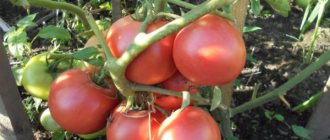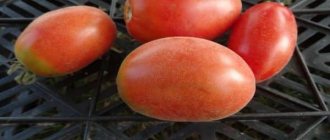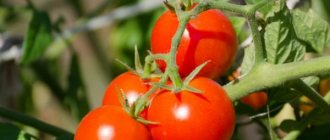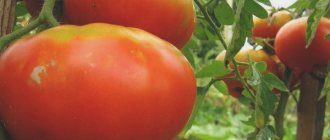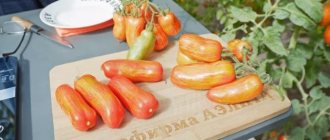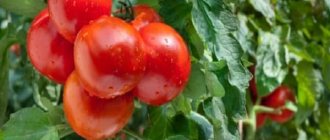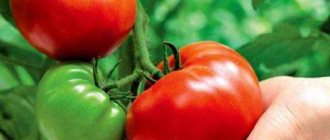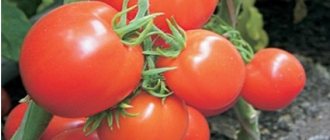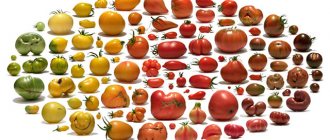Russian Bogatyr is an incredibly tasty and healthy variety of tomatoes that is so difficult to find on store shelves. People fall in love with him after the first harvest. Novice gardeners like it for its ease of care and cultivation.
The plants present gardeners with large, fleshy fruits. Many positive qualities in one variety - this is the Russian Bogatyr tomato. We will tell you in detail how even a novice summer resident can get his harvest of these tomatoes and describe the step-by-step growing process from seed preparation to harvesting.
Characteristics and description of the variety
Russian Bogatyr lives up to its name: a huge spreading bush grows up to 2 m in height, bearing 5-6 kg of large fruits. On each bush, several clusters are formed, on which 4-5 tomatoes ripen. By the end of summer, the Russian Bogatyr tomato variety brings summer residents an abundant and high-quality harvest. Since the bushes of this variety are very spreading, they need tying and pinching.
The fruits of the Russian Bogatyr are large, fleshy, bright pink or red in color, and contain a minimum of seeds and water. The fruits have a thin but dense skin, which prevents cracking even when cutting.
Among other things, the fruits of the Russian Bogatyr have an unusually pleasant aroma and a delicious sweetish taste, not at all similar to the taste of store-bought tomatoes. That is why tomatoes of this variety are so popular on the holiday table, both fresh and canned. Russian Bogatyr tomatoes are perfect for obtaining tomato juice, which is not made from all varieties.
Russian Bogatyr is a mid-season tomato. Its ripening period varies from 95 to 105 days after germination. Plants bear fruit not once during the summer, but 2 or even 3 – right up to autumn. Considering the weight of each fruit - 350-450 g - one can only imagine how many tomatoes you will collect by the end of summer from just one garden bed. On the lower clusters, the fruits reach a weight of 700 g - you are guaranteed abundance on the table.
The shape of each fruit is slightly flattened, with pronounced ribs at the base. As the fruit ripens, it changes color from green to deep pink and red.
Main characteristics of the variety
The main difference between “Bogatyr” and other varieties is its characteristics:
- Determinate variety (limited in growth);
- Large-fruited;
- Productive (about 10 kg per sq. m. or 3-4 kg per bush);
- Medium early (the first fruits appear 3.5 months after seed germination);
- Short (on average reaches 70-90 cm);
- Does not require gartering or pinching;
- Resistant to tomato diseases (such as root and blossom end rot).
The bush itself is medium-leaved, the leaves are bright green, slightly ribbed. The fruits of the Bogatyr variety have a round shape with a smooth, slightly ribbed surface. The average weight of tomatoes is 200-400 g. Ripe tomatoes are bright red in color, have few seeds, are aromatic, very tasty, and do not crack despite their large size.
We grow seedlings
The process of growing seedlings has a standard technology. By following our instructions, you can easily germinate seeds and prepare seedlings for planting at home.
Seed preparation
Preparing seeds is a mandatory step when planting any plant.
First, purchased seeds must be disinfected. Place the seeds in warm water with a pinch of potassium permanganate and leave for half an hour. After this, start germination. Germination begins with laying out rows of seeds on a hard flat surface (tray, baking sheet, box or holes). Cover the top of the seeds with moistened gauze. Do not choose another fabric: gauze is best at feeding the seeds with moisture and allowing them access to air.
Important! The gauze must always remain damp for the seeds to germinate. When the gauze dries, moisten it with water from a spray bottle to avoid “flooding” the seeds.
To increase germination, growth stimulants are used - “Epin”, aloe juice with water.
Planting seeds
To plant seeds, you need to prepare a container, such as a box, and soil. Partially place the soil in a container, loosen it first, and water it a little. Then place the sprouted seeds in the soil in rows at a distance of 1.5 cm from each other and to a depth of about 2 cm. Then sprinkle a little earth on top and leave in a warm place for several days. Water the soil a little every day without letting it dry out.
Important! To create conditions close to greenhouse conditions, cover the box with transparent film. This will retain heat and contribute to the rapid formation of seedlings.
After germination, keep the box in a warm and constantly lit place. If there is not enough natural light, special fluorescent lamps create such conditions. These lamps are very helpful for gardeners, since when growing seedlings the light must be not only constant, but also comprehensive. Sunlight, as a rule, provides illumination only from one side of the box, which negatively affects seedlings.
It is also necessary to monitor the temperature in the room: it should be at least +20 degrees for healthy sprouts to appear. After 10 days, when the first shoots appear, bring this temperature closer to room temperature.
3-4 days after planting, the seeds should germinate, and after 2 weeks they should become seedlings. As soon as the first leaves appear on the seedlings, transplant them into separate containers (for example, plastic or clay cups) so that they do not interfere with each other. The main conditions for the full development of sprouts: regular watering, constant temperature. Then, after about a month and a half, your sprouts will be ready for planting in the ground.
Attention! To harden the plants and prepare them for transplanting into the greenhouse, periodically take the box outside or place it in an open window. Increase the time from a few minutes to 8-10 hours.
Planting seedlings
Seeds for seedlings are sown towards the end of March or early April. Separate pots are more suitable for this purpose, because... the plant is low growing. It will need more space in width than in height. The soil should be highly fertile; you can buy ready-made soil mixture for seedlings. Before planting, all seeds are pre-selected by soaking in a saline solution for 5-7 minutes. To disinfect seeds, they are treated with a solution of potassium permanganate and washed with water. The material is now ready for planting.
Plant the seeds to a depth of 2-3 cm, sprinkle with soil and water with warm water. It is important to ensure that the water is not cold, because... This particular variety is very thermophilic. If the seedlings were planted in pots, then picking is not required. If in a box, then after the appearance of 2 leaves, picking is carried out. This is necessary to ensure normal growth and development of seedlings.
As the seedlings grow, they need to be fed. This is done 3 times during the entire period of seedling growth. About 10 days before planting in the ground, the seedlings are hardened off: they are taken outside for several hours a day. This way ensures that plants get used to fresh air and reduces the risk of tomatoes dying due to a sudden change in the environment.
Growing tomatoes in a greenhouse
The time for planting sprouts in the ground is approximately in May (if the seeds were collected in March). It is preferable to plant the sprouts in a greenhouse, even if in the future you plan to transplant them into open ground. Young shoots are extremely sensitive to temperature changes.
For proper planting of tomatoes and further care for them, follow the instructions below.
Landing
The soil must be dug up and formed into beds. Each bed is moistened and mineral or organic (for example, humus) fertilizers are added to the soil. It is better to administer them in the form of an aqueous solution.
Carefully move each seedling from the container into the soil and sprinkle it on top with soil so that the roots of the plant are covered by 2 cm on top. Place the seedlings approximately 25 cm apart. So 4-5 bushes fit in one square meter.
Important! Do not plant the sprouts close to each other, as the Russian Bogatyr tomato has a spreading bush.
After planting, lightly water the beds again and leave them in the greenhouse. In the future, the sprouts will require regular watering, and they need to be fertilized 1-2 times a month.
Care
Caring for tomato bushes includes tying, pinching, watering, weeding, loosening and fertilizing the soil:
- Tying. Russian Bogatyr tomatoes grow large, both in the size of the fruit and in the size of the bush itself, so tying is necessary. This procedure is necessary so that, under the weight of large fruits, the branches of the plant do not break off and sink to the soil, as this will damage the fruits. There are 2 types of tying: vertical and horizontal. In the vertical type, the plant is tied to a vertical support (a peg or stick previously driven into the ground). Each branch is attached to a support and left fixed. When tying horizontally, plant branches are attached to a horizontal support (trellis). As a rule, a rope or wire stretched along the greenhouse closer to the top is chosen as such a support. Ropes supporting branches with fruits are tied to this support in the same way. For this variety of tomatoes, it does not matter which garter you choose: horizontal or vertical.
- Watering. The Russian Bogatyr tomato variety is unpretentious in watering, even in arid regions. If you forgot to water the garden bed, no problem: Russian Bogatyr does well without moisture for up to 2 weeks. However, it is better to water the tomatoes 2-3 times a week. When watering, make sure that drops of water do not fall on the leaves of the plants, so keep the watering can close to the ground. With abundant moisture, a fungal infection or burns caused by exposure to sunlight appears on the leaves.
- Weeding. Russian Bogatyr is not particularly picky about weeding, but do not forget that large weeds take nutrients from the plant, so they should be removed in a timely manner. As for small weeds, remove them as they grow.
- Loosening the soil. This is done so that the soil does not harden and allows the bush to grow freely, as well as to saturate the plant roots with oxygen. Weed the bed as the weeds grow, but be sure to loosen it after each watering. Loosening is done using a hoe or a special garden spatula.
- Fertilizing the soil. Fertilize tomatoes 1-2 times a month. Both mineral and organic fertilizers are used. Fertilizers promote the growth of healthy bushes and a bountiful harvest. Add fertilizers either to the soil itself when loosening, or to the water for irrigation.
- Stepsonning. Not many novice gardeners know about pinching, but in vain: in our case, this is a mandatory procedure for caring for tomato bushes. When pinching, young shoots and non-fruit-bearing branches that grow strongly are removed. Such shoots take away nutrients, which slows down the growth and development of fruiting branches. The treated bushes, which look like a stem and several fruit-bearing branches, produce a bountiful harvest. This procedure greatly simplifies the growth of the plant and its fruits and has a positive effect on the taste and quantity of fruits.
Diseases and pests
An integral part of plant care is pest and disease control. The Russian Bogatyr variety makes life much easier for summer residents, as it is immune to many diseases and is rarely attacked by pests. However, in any case, a good gardener should know the most common tomato diseases and pests, and practice ways to combat them.
The most common disease of tomatoes is late blight . This is a disease of fungal origin, which manifests itself in various spots on the leaves. This disease occurs if you water the bush too often and too much or if water gets on the leaves. Therefore, to prevent disease, it is necessary to follow the watering regime and not flood the beds. If the disease has already appeared, then the best control is to collect the affected leaves so that the disease does not spread from one leaf to another.
Important! Diseased leaves or plants are burned after removal.
After collecting the affected leaves, treat the plants with a copper-containing solution.
This is a preventative measure that helps prevent the infection from spreading further and kills it. Another disease is mosaic. It is also characterized by the appearance of white-yellow spots on the leaves and stem of the plant. However, infection occurs not through water, but through insects. The most common distributor of mosaic is aphid. Diseased areas dry out and fall off over time.
As a preventive measure and treatment for mosaic, spray the bushes with copper-containing preparations and a soap solution (4 tablespoons of liquid soap per 1 liter of water). The affected areas also need to be torn off and burned without waiting for them to spontaneously fall off.
It is worth remembering about a variety of insect pests and disease carriers. In addition to aphids, which spread the infection, these are Colorado potato beetles, whiteflies and mole crickets. All these insects harm plants in their own way. The whitefly eats the foliage along with the nutrients necessary for fruit growth. The cockchafer lays larvae in the soil, which eat the roots of the plant, causing it to subsequently die. The same damage is caused by the mole cricket and the Colorado potato beetle.
If pests are detected, it is necessary to treat the bushes and soil with a soap solution or special insecticide preparations that are sold in gardening stores.
If you follow all of the above instructions, namely stabilize the regime of watering, weeding, loosening, tying up bushes, feeding, pinching and preventing and treating diseases, destroying pests, by mid-summer you are guaranteed to receive a bountiful harvest of ripe Russian Bogatyr tomatoes.
Growing and care
The first step in growing tomatoes is planting seeds for seedlings. This is done already in the second half of February. Sow seeds in containers to a depth of no more than one centimeter. The containers are placed in a warm place and when the first true leaves appear on the seedlings, the seedlings are planted in separate pots. During picking, the plant is fed with complex fertilizer.
Before planting in the soil, the seedlings are hardened, gradually keeping them outside, when the hardening time has already been reached to the maximum: the seedlings have been standing outside for at least a day and when the soil has already warmed up sufficiently, the seedlings are planted in open ground.
Important to remember! Experts recommend this variety for growing in greenhouses. In greenhouses, the plant must be provided with proper and timely watering, sufficient ventilation and fertilizing. In greenhouses, the plant must be provided with proper and timely watering, sufficient ventilation and fertilizing.
In greenhouses, the plant must be provided with proper and timely watering, sufficient ventilation and fertilizing.
Before planting the seedlings, holes are formed into which the seedlings are planted, then they are sprinkled with earth, lightly compacted and watered.
Then you should provide the seedlings with complete rest. The next watering is carried out after 10 days, since too wet soil is contraindicated for tomatoes. Then, before the flowering period, water the tomatoes as the soil dries; for this, use 3-4 liters of water per square meter. At the hour of active fruit formation, the plant needs more abundant watering. At this time, water consumption must be increased to 10-12 liters per square meter.
Strictly prohibited! Water the tomatoes with cold water. It must be heated to 20-22 degrees. To do this, you can use large containers that are placed in the sun and filled with water early in the morning.
You should also not water with stagnant, stale water, as this can contribute to tomato diseases. During the period of active fruiting and fruit ripening, the plant is watered after 5-7 days.
Air humidity is also a very important point. With high humidity, the plant will not be pollinated in sufficient quantities.
Pollination of tomatoes occurs naturally, but to increase yield, mechanical pollination can be additionally carried out. To do this, the branches of the plant need to be gently shaken periodically. It is best to do this during the day, in bright sunny weather. After mechanical pollination, the flowers must be sprayed and the greenhouse must be ventilated.
Ventilation is an extremely important factor in caring for greenhouse tomatoes. To do this, greenhouses must be equipped with windows.
An equally important detail is the temperature regime in the greenhouse. During the day it is necessary to maintain the same temperature at 22 degrees, at night - 20 degrees will be enough. When the period of flowering and fruit ripening begins, the temperature should be 2-3 degrees higher, but should not exceed 26-27 degrees.
If you have read in detail the characteristics and description of the Samara tomato variety, then growing such a popular variety of tomato yourself will not be difficult or difficult for you. But as a result, there will always be tasty, sweet and aromatic vegetables on your table.
This variety of tomatoes is suitable for both fresh raw consumption and canning. The fruits are quite elastic, do not crack, and you can always treat yourself to delicious salted or pickled tomatoes from a jar. This variety also produces excellent tomato juice, as evidenced by numerous positive reviews from summer residents and housewives.
https://agronom.expert/posadka/ogorod/paslenovye/tomat/samara.htmlhttps://web-selo.ru/sort-pomidora-samara-foto-video-otzyvy-opisanie-harakteristika-urozhajnost.htmlhttps:// dachamechty.ru/tomat/sort/samara.html
The nuances of growing in open ground
Russian Bogatyr tomatoes are suitable for growing both in greenhouses and in open ground. However, the variety is heat-loving and still prefers a greenhouse, where it produces a more abundant harvest. Tomatoes are planted in open ground in warm climates or hot summers. At the same time, make sure that the bed is not overly flooded with precipitation and gusts of wind do not break the stems of the plant.
We list the points that are worth remembering when planting in open ground:
- Moisture. Excessive precipitation in the form of rain on the beds reduces yields, promotes the development of fungal diseases or even the death of the plant. In addition, infectious pathogens (for example, late blight) are more often found in rainwater.
- Pests. Pests are much more likely to attack plants planted in open areas than those growing in a greenhouse. It is easier for insects to lay larvae in open ground and it is easier for them to easily reach tomato foliage.
- Temperature. Due to its special love for warmth, the Russian Bogatyr tomato bears less fruit in open ground. When planting in an open bed, cover it with plastic wrap at night, but this is not always enough. It is necessary to monitor the temperature, prevent the plant from overcooling and tie it tightly to avoid fractures of the stem and branches. Moreover, in open ground, Russian Bogatyr will begin to bear fruit later.
Growing stages
Altai tomatoes are intended for cultivation in regions of risky farming, and therefore seedlings must first be grown.
Seedling care
Seeds first undergo pre-sowing treatment:
- disinfection in special compounds (usually potassium permanganate);
- soaking in growth stimulants (aloe juice, ash infusion, store-bought preparations Epin or Zircon);
- germination in a damp cloth or gauze.
Prepare boxes, pots, cups, as well as nutritious soil for tomatoes in advance. You can use store-bought formulations (just carefully read the information on the packages), or you can prepare the mixture yourself.
Stores often offer soil for seedlings, which consists of only peat. Such soil cannot be used in its pure form; it is necessary to add turf soil, humus, and raising agents (river sand, perlite, vermiculite) to it.
Also add wood ash and superphosphate to the soil mixture. Sowing dates are determined taking into account the time of planting tomatoes in a greenhouse or on ridges; at this point the age of the tomatoes should be about 60-65 days. Usually, seeds of this variety are sown for seedlings in March, so that already in May or early June, the grown plants can be identified for a permanent place.
Seedlings growing in boxes are planted in separate containers; after about 10-12 days, the tomatoes can be fed with Kemira or Agricola. In total, for tomatoes growing at home, two feedings are carried out. Water very moderately, avoiding excess moisture in the soil.
Harvesting and application
When the Russian Bogatyr tomato turns bright pink or red, this indicates the ripeness of the fruit. This usually occurs by the end of July, but can continue until the end of September.
Picking tomatoes is the simplest and most enjoyable part of the growing process, but there is also a certain technology in this matter. To ensure that the fruits retain their shape and beautiful appearance, carefully remove them from the branch without damaging the branch itself and the skin of the fruit. Hold the fruit with one hand, hold the branch with an arc and slowly pull it towards you. If the tomato is truly ripe, it will end up in your hand without much effort.
Place tomatoes in a container (for example, a box), which you have previously covered with paper, in rows to avoid bruises. You should not put more than 2 layers of tomatoes in one box - this way they will remain denser and maintain their integrity.
Next, place the boxes in a dry place, but protected from direct sunlight. Do not allow the fruits to rot. To prevent the putrefaction process from starting on tomatoes, store them at a temperature of +14-17 degrees and do not allow them to get wet.
If you want to transport fruits over long distances, pick them slightly unripe. This will help deliver the fruits to the right place just in time for them to ripen. Slightly greenish tomatoes tend to ripen already in boxes.
The use of tomatoes is extensive: tomatoes will pleasantly surprise you and your guests with their taste, both fresh and cooked or pickled. Russian Bogatyr is perfect for tomato paste and tomato juice.
Everyone's favorite Russian dish - homemade borscht - will sparkle with new colors and aromas if you add slices of stewed tomato to the broth.
Don’t forget about the beneficial elements contained in tomatoes and their positive effect on health and well-being. Tomatoes strengthen the immune and cardiovascular systems, have a beneficial effect on blood vessels and prevent the development of many diseases. It has been proven that tomatoes also improve well-being and mood due to the serotonin they contain. In addition, it is a powerful antioxidant.
Advantages and disadvantages of the variety
Main advantages of the variety:
- large, fleshy fruits with few seeds;
- bountiful harvest;
- resistance to diseases and pests;
- ease of care;
- duration of fruiting.
Among the shortcomings we note:
- heat-loving (preferably grown in a greenhouse);
- the need for tying and pinching.
Diseases and pests: how to deal with them
This variety is quite resistant to diseases, and it is also little affected by tomato pests. But to get an excellent harvest, prevention will not be superfluous, therefore:
- be sure to observe crop rotation on the site;
- carry out pre-sowing disinfection of seeds;
- From about the end of June, tomatoes are treated with Bordeaux mixture and copper-containing preparations;
- do not allow high humidity in the greenhouse.
Garlic infusion and soap compositions are used for pest control treatments.
What farmers say
A large number of reviews, as a rule, speak of the outstanding qualities of a particular variety of tomatoes. Russian Bogatyr is loved by modern gardeners, and therefore has many positive reviews. Here are some of them:
Sergey Ivanov, Leningrad region: “The Russian Bogatyr is truly a hero! Just look at the photo! I have never grown such large fruits myself! And most importantly, he did it without much effort.”
Maria Onopchenko, Volkhov: “Excellent tomatoes, very easy to grow, I tell you as a novice gardener. There were no problems with disembarkation or departure.”
Anna Moiseeva, Moscow: “For fun, I planted a couple of bushes in my dacha. And they grew up! And they bore fruit! Did not expect. I started growing them every year. Now there are always fresh tomatoes on the table.”
Galina Ladyzhnikova, Veliky Novgorod: “Russian Bogatyr is a cook’s dream. These large tomatoes allow you to bring all your culinary ideas to life. And the tomato paste they make is simply excellent!”
